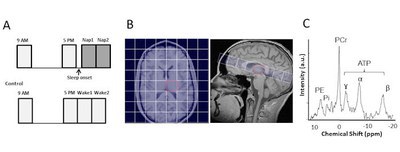Diurnal metabolic changes in human brain
Diurnal alterations of cerebral energy supply have been the focus of many recent studies. Modalities such as PET, MRI, EEG and behavioral tests provided a wide spectrum of parameters to characterize different states of wakefulness and sleep propensity. Regarding this, 31P-MRS serves as an appropriate method providing the opportunity to study diurnal metabolic alterations in the brain. The alterations reveal a change of high energy phosphate levels such as PCr and ATP during the day or after sleep deprivation.
In order to detect changes of PCr, Pi and γ-ATP signals we used a longitudinal study design including measurements of healthy humans in the morning, the afternoon and during a short nap (Fig.1).

Fig.1: A. 30 subjects were measured in two sessions, one in the morning at 9 AM and one in the afternoon at 5 PM within the same day. After the afternoon 5 PM scan at wake state, 15 subjects remained positioned in the scanner and were further measured while napping. B. Sagittal and axial 2D flash image in radiological orientation (left hemisphere at the right image side) overlain with the CSI grid of 8 × 8 voxels. C.31P spectrum of the left thalamic voxel.
Our study revealed a diurnal decrease of PCr and a nap associated re-increase in the left thalamus. Pi behaved inversely (Fig.2). Our findings indicate a lateralization of thalamic function, since the increase of Pi/PCr was pronounced in the left thalamus.

Fig.2: Plots of the courses of PCr (A) and Pi (B) in the left thalamus voxel throughout the 4 conditions assessed. Dotted lines represent the control group that did not nap. C. Top: Voxel-wise concentrations of PCr, Pi and γ-ATP at 9 AM were quantified. Bottom: Pi/PCr changes throughout the 4 condition. Green filled circle: changes which did not withstand the Benjamini-Hochberg corrections.
This outcome corroborates the role of the thalamus as a region of high energy consumption in agreement with its function as a gateway, relaying and modulating the information flow. Conversely to the dynamic lateralization of thalamic PCr, a constantly significant lateralization was observed in other regions. Increasing fatigability in the course of the day may be also a matter of cerebral energy supply and the comparatively fast restoration thereof contribute a biological basis for the recreational value of “power napping”.
More information under https://www.jneurosci.org/content/38/49/10552
